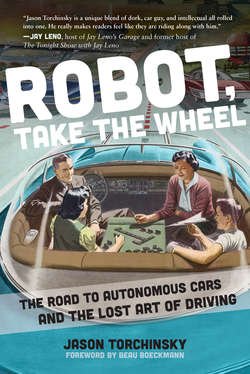Читать книгу Robot, Take the Wheel - Jason Torchinsky - Страница 15
На сайте Литреса книга снята с продажи.
1925: Houdina American Wonder
ОглавлениеThe first conventional automobile to be driven without a person at the wheel was developed in 1925, but it’s really sort of a cheat. It wasn’t an autonomous car, but rather a remotely controlled car, so it was still driven by a human even though the human wasn’t inside the car.
Pictures of the car show it labeled as a “1926 Chandler,” which is sort of confusing, since it appears to have been demonstrated and in operation since 1925. The car, nicknamed the “American Wonder,” was built by an electrical engineer named Francis P. Houdina.
The way it worked was pretty straightforward: the car had a kite-shaped receiving antenna mounted on the tonneau, and electric motors under radio control to actuate the controls. It’s not entirely clear how many of the car’s controls were controlled by the motors or how the mechanisms worked. We do know the steering seems to have been accomplished with a belt or similar device around the steering shaft itself, because a poor grip on the steering column caused some excitement during a demonstration drive in New York in the 1920s.5
Here’s how the New York Times described it:
A loose housing around the shaft to the steering wheel in the radio car caused the uncertain course as the procession got underway. As John Alexander of the Houdina Company, riding in the second car, applied the radio waves, the directing apparatus attached to the shaft in the other automobile failed to grasp it properly.
As a result the radio car careened from left to right, down Broadway, around Columbus Circle, and south on Fifth Avenue, almost running down two trucks and a milk wagon, which took to the curbs for safety. At Forty-seventh Street Houdina lunged for the steering wheel but could not prevent the car from crashing into the fender of an automobile filled with camera men. It was at Forty-third Street that a crash into a fire engine was barely averted. The police advised Houdina to postpone his experiments, but after the car had been driven up Broadway, it was once more operated by radio along Central Park drives.6
It seems that, at a minimum, there were mechanisms for steering, starting the car, actuating the throttle pedal and brake pedal, and perhaps clutch and shifting. It’s possible they just left it in first or maybe second gear, though I think they’d need some degree of clutch actuation.
The thing seemed to work generally well enough for a proof of concept, and in the overall scope of autonomous vehicles the American Wonder proved that motors, servos (automatic devices with some form of error-sensing and correction), and similar mechanisms could be used to actuate conventional car controls in place of actual human limbs and hands. If we replace those radio signals from a human with signals from onboard cameras, sensors, and computers, you’ve effectively got the basics of how modern autonomous vehicles are built.
One fascinating footnote to this has to do with the inventor’s name: Houdina. As you probably already noticed, that name is an awful lot like Houdini, as in Harry Houdini, the famous illusionist and escape artist. Houdini was not the sort of person to take guff of any kind, ever, and he felt that Houdina was deliberately using a name that sounded like Houdini for the name of his company, Houdina Radio Control Co. Houdini didn’t seem to care that the man’s name was, in fact, Houdina, and was convinced it was all just some dirty ploy to capitalize on Houdini’s success and name recognition. Guys who escape from chains underwater don’t usually write tersely worded letters, and Houdini instead opted for the more direct method of going to Houdina’s office and trashing the place.
Houdini wrecked some furniture and an electric chandelier, and pitched what must have been a very exciting fit. Houdini was summoned to court regarding the incident, but no one from Houdina showed up, so Houdini got away scot-free with the perfect crime of chandelier damage.
